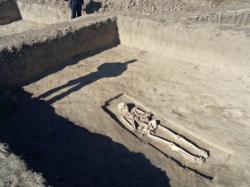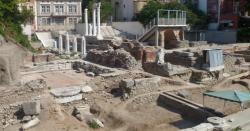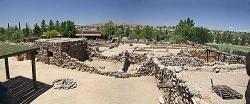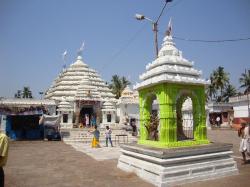INSTITUT SUPERIEUR D'ANTHROPOLOGIE
INSTITUTE OF ANTHROPOLOGY
ONLINE COURSES / COURS A DISTANCE
NEW OPEN COURSE : JANUARY 2013
HRM 104 : INTRODUCTION TO INTANGIBLE CULTURAL HERITAGE
REGISTER NOW
BULGARIE –  Marten - A necropolis with over 100 burials has been unearthed during archaeological excavations near the village of Marten in northern Bulgaria. The discovery was made by the archaeologist from the Archaeology Museum in the Danube city of Ruse, Deyan Dragoev. The necropolis is on the path of the future gas connection between Bulgaria and Romania. The site includes tombs from the Thracian times to the times of the First Bulgarian Kingdom. The oldest ones date from the 5th – 4th centuries B.C. Some reveal very interesting rites such as the tomb of a decapitated soldier, whose head was laid on his lap, while others have been buried with gold and silver jewelry or with their dogs. Some skeletons have deformed skulls, which have been typical for the First Bulgarian Kingdom as a sign of high position in society and of nobility. Noble children then had their heads tightened with headbands in order to change the form of the skull, experts say. Remnants include wooden coffins, and ceramics and glass from Roman times. The two Thracian tombs, according to archaeologists, show that a Thracian settlement, unknown until now, has been located nearby.
Marten - A necropolis with over 100 burials has been unearthed during archaeological excavations near the village of Marten in northern Bulgaria. The discovery was made by the archaeologist from the Archaeology Museum in the Danube city of Ruse, Deyan Dragoev. The necropolis is on the path of the future gas connection between Bulgaria and Romania. The site includes tombs from the Thracian times to the times of the First Bulgarian Kingdom. The oldest ones date from the 5th – 4th centuries B.C. Some reveal very interesting rites such as the tomb of a decapitated soldier, whose head was laid on his lap, while others have been buried with gold and silver jewelry or with their dogs. Some skeletons have deformed skulls, which have been typical for the First Bulgarian Kingdom as a sign of high position in society and of nobility. Noble children then had their heads tightened with headbands in order to change the form of the skull, experts say. Remnants include wooden coffins, and ceramics and glass from Roman times. The two Thracian tombs, according to archaeologists, show that a Thracian settlement, unknown until now, has been located nearby.
http://www.novinite.com/view_news.php?id=145551
BULGARIE –  Plovdiv - Archaeologists working at the Odeon site in Bulgaria’s second city of Plovdiv have found 40 silver coins said to date from the third century CE when the city was under Roman rule. The coins were said by archaeologists to have been minted during the Severan dynasty, while ruled from 193 to 235 CE and variously feature images of four different emperors. The Odeon site, dating from the second to fifth centuries, is the location of a Roman-era theatre, and is smaller in scale than Plovdiv’s well-known ancient theatre in the city’s Old Town. The coins were found near the complex of administrative buildings at the northern end of the forum complex. This archaeological season, more than 600 coins have been excavated at Plovdiv’s Odeon site. From the Hellenic era, there have been many finds of pottery. At the Odeon site, a marble eagle was found earlier in 2012, and is estimated to date from the second to third century. Maya Martinova, head of the dig at the site, said that the eagle was of a type from the interiors of public buildings, and along with finds of marble columns and other items, was proof of the luxurious interiors of buildings in Phillipopolis, a prosperous city at the time. The Odeon site has also seen finds of tiles depicting theatrical masks and Roman pottery. The coins include some with the images, respectively, of the emperors Geta and Caracalla, minted in ancient Sofia and in ancient Plovdiv at the end of the second and beginning of the third centuries.
Plovdiv - Archaeologists working at the Odeon site in Bulgaria’s second city of Plovdiv have found 40 silver coins said to date from the third century CE when the city was under Roman rule. The coins were said by archaeologists to have been minted during the Severan dynasty, while ruled from 193 to 235 CE and variously feature images of four different emperors. The Odeon site, dating from the second to fifth centuries, is the location of a Roman-era theatre, and is smaller in scale than Plovdiv’s well-known ancient theatre in the city’s Old Town. The coins were found near the complex of administrative buildings at the northern end of the forum complex. This archaeological season, more than 600 coins have been excavated at Plovdiv’s Odeon site. From the Hellenic era, there have been many finds of pottery. At the Odeon site, a marble eagle was found earlier in 2012, and is estimated to date from the second to third century. Maya Martinova, head of the dig at the site, said that the eagle was of a type from the interiors of public buildings, and along with finds of marble columns and other items, was proof of the luxurious interiors of buildings in Phillipopolis, a prosperous city at the time. The Odeon site has also seen finds of tiles depicting theatrical masks and Roman pottery. The coins include some with the images, respectively, of the emperors Geta and Caracalla, minted in ancient Sofia and in ancient Plovdiv at the end of the second and beginning of the third centuries.
http://sofiaglobe.com/2012/11/28/archaeology-40-silver-roman-coins-from-3rd-century-found-at-odeon-site-in-bulgarias-plovdiv/
USA –  Besh Ba Gowah - The ancient Besh-Ba-Gowah ruins in Globe has one of the largest single site archaeological collections in the southwest and is one of the most significant finds of Southwest archaeology. Occupied from 550 AD, first by the Hohokams, then by the Salado people from 1150 AD to 1450 AD.The area apparently remained uninhabited for centuries until the Apache people made it their homeland sometime after 1600 AD. Besh-Ba-Gowah is situated along an ancient major trade route from Chihuahua, Mexico that passed along Pinal Creek en route to the Salado River. Besh-Ba-Gowah is viewed as having been a cosmopolitan trade center. Exports included turquoise, beads, and ceramic bowls. Imports included shells from the Gulf of Mexico, the Pacific Ocean and the Gulf of Mexico. Cotton from lower altitudes was woven into cloth. The Besh-Ba-Gowah potters were masters of the craft. Salado Culture pottery has the largest area distribution of any Southwest ware.
Besh Ba Gowah - The ancient Besh-Ba-Gowah ruins in Globe has one of the largest single site archaeological collections in the southwest and is one of the most significant finds of Southwest archaeology. Occupied from 550 AD, first by the Hohokams, then by the Salado people from 1150 AD to 1450 AD.The area apparently remained uninhabited for centuries until the Apache people made it their homeland sometime after 1600 AD. Besh-Ba-Gowah is situated along an ancient major trade route from Chihuahua, Mexico that passed along Pinal Creek en route to the Salado River. Besh-Ba-Gowah is viewed as having been a cosmopolitan trade center. Exports included turquoise, beads, and ceramic bowls. Imports included shells from the Gulf of Mexico, the Pacific Ocean and the Gulf of Mexico. Cotton from lower altitudes was woven into cloth. The Besh-Ba-Gowah potters were masters of the craft. Salado Culture pottery has the largest area distribution of any Southwest ware.
http://copperarea.com/pages/?p=1068345
INDE – Bangalore - After finding two cannons at the Metro construction site near Vanivilas Hospital, the state archaeology department is now planning to sensitise Metro workers on the city’s history. They hope that this will help the workers handle possible findings in future or even identify them. The discovery of the two cannons at the Metro site has once again revived concerns with regard to protecting the heritage of old Bangalore, while allowing the construction of the Metro. Before the Metro construction had begun, many questions were raised with regard to allowing the construction work in these areas and a change in the route was suggested. However, with the project already having been sanctioned, there was not much to be done. Since the cannons were found, questions have been raised with regard to how capable Metro workers are to identify artefacts of historical value or even understand the historical importance of the area.
http://www.dnaindia.com/bangalore/report_archaeology-dept-to-sensitise-bmrcl-workers-on-citys-heritage_1770087
INDE – Kendrapara - Experts of State Archaeology and director of culture Sushil Kumar Das on Tuesday inspected the 400-year-old Baladevjew temple in the town to ascertain the cause of falling of stones from the ancient structure.Archaeologist Aswini Kumar Satapathy said the temple would be examined thoroughly and necessary repairs taken up as per the advice of the statutory technical committee. A stone slab weighing 50 kg had fallen from the temple on Saturday, leading to cracks on the main temple.
Kendrapara - Experts of State Archaeology and director of culture Sushil Kumar Das on Tuesday inspected the 400-year-old Baladevjew temple in the town to ascertain the cause of falling of stones from the ancient structure.Archaeologist Aswini Kumar Satapathy said the temple would be examined thoroughly and necessary repairs taken up as per the advice of the statutory technical committee. A stone slab weighing 50 kg had fallen from the temple on Saturday, leading to cracks on the main temple.
http://timesofindia.indiatimes.com/city/bhubaneswar/Experts-inspect-Baladevjew-temple/articleshow/17396760.cms